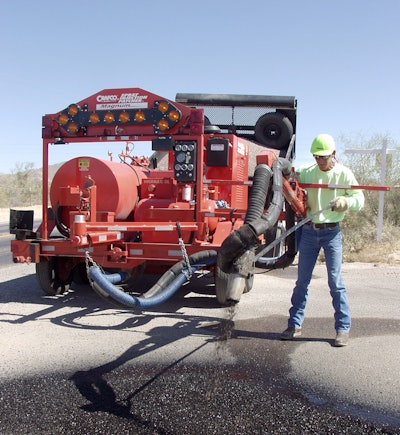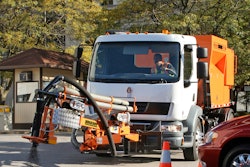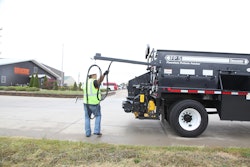
Spray-injection patching machines are available in tow-behind (e.g. Magnum), truck-mounted (e.g. Airstream) and standalone vehicles. However, the process is similar on all equipment and that starts with cleaning the pothole using air pressure to blow water and debris from a pothole, spraying a tack coat of binder on the insides and bottom of the hole, blowing asphalt and aggregate into the hole at 50 to 90 mph, compacting from the bottom up, and then covering the patched area with a layer of aggregate. Pavement can be opened to traffic immediately.
Spray patching is done via a low-pressure system, which delivers the necessary air, aggregate and emulsion at a rate of just three to four PSI. It includes four basic steps. First, air pressure removes water, dirt and any debris are removed from the pothole. Next, the interior of the pothole is sprayed with a coat of liquid asphalt to help ensure a strong bond between the aggregate mix and existing asphalt.
Using high-velocity air in conjunction with a screw auger, the pothole is then filled with the mix, typically consisting of hot asphalt and liquid-covered rock, which bonds to the existing pavement. The air pressure that delivers the coated aggregate material to the repair also compacts the material from the bottom up, leaving virtually no voids in the final pavement repair and making a long-lasting patch that is superior to conventional methods as proven by government studies. Finally, the patch is sealed with a dry coat of aggregate to enhance durability and longevity.
The technology has been around for decades and spray injection is a widely accepted form of pothole repair. In fact, numerous cities and state agencies across the country have adopted the method because the machines can reduce the manpower needed on the job, repair more pavement quicker, limit worker exposure to traffic, and disrupt traffic and the public for a shorter period of time. With these machines, contractors will be able to reduce their overhead by hiring fewer people to get the work done, or can reallocate that labor to other jobs, improving productivity.




















